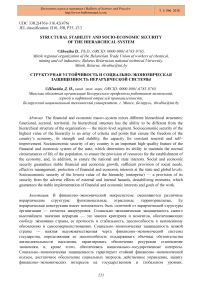Structural stability and socio-economic security of the hierarchical system
Автор: Shvaiba Dzmitry
Журнал: Бюллетень науки и практики @bulletennauki
Рубрика: Экономические науки
Статья в выпуске: 6 т.4, 2018 года.
Бесплатный доступ
The financial and economic macro-system mixes different hierarchical structures: functional, sectoral, territorial. Its hierarchical structure has the ability to be different from the hierarchical structure of the organization - the micro level segment. Socioeconomic security of the highest value of the hierarchy is an array of criteria and points that ensure the freedom of the country’s economy, its strength and stability, the capacity for constant renewal and self-improvement. Socioeconomic security of any country is an important high-quality feature of the financial and economic system of the state, which determines its ability to maintain the normal circumstances of life of the population, to ensure the provision of resources for the establishment of the economy, and, in addition, to ensure the national and state interests. Social and economic security guarantees stable financial and economic growth, sufficient provision of social needs, effective management, protection of financial and economic interests at the state and global levels. Socioeconomic security of the lowest value of the hierarchy (enterprise) - a provision of its security from the adverse effects of external and internal hazards, destabilizing moments, which guarantees the stable implementation of financial and economic interests and goals of the work.
Socio-economic security, government, society, enterprise, employee, threat, security, interests, economics, analysis, system
Короткий адрес: https://sciup.org/14112102
IDR: 14112102 | УДК: 338.2(476)+316.42(476) | DOI: 10.5281/zenodo.1289852
Список литературы Structural stability and socio-economic security of the hierarchical system
- Chernavsky, D. S. (2004). Synergetics and Information: Dynamic Information Theory. Moscow, Editorial URSS, 287.
- Krasnova, N. A. (2013). Innovations in economic theories of different schools. Economics and management of innovative technologies, (12). Access mode: http://ekonomika.snauka.ru/2013/12/3476 (date of circulation on 26.05.2017).
- Pazdnikova, N. P. (2016). Security of program-targeted management of regional socio-economic systems. Bulletin of the Samara State University of Economics, (1), 14-21.
- Berg, E. J., & Ostri, J. O. (2013). Inequality and unsustainable growth: two sides of the same coin. Bulletin of International Organizations: education, science, new economy, 8(4), 77-99.
- Shvayba, D. N. (2017). Problems of coordinating goals and vital interests while ensuring social and economic security. Science and Technics, 16(6), 526-531.
- Lebedev, V. V. (1997). Mathematical modeling of socio-economic processes. Moscow, Izograf, 224.
- Malinetskii, G. G. (2000). Chaos. Structures. Computational experiment: introduction to nonlinear dynamics. Moscow, Editorial URSS, 253.
- Reznikov, A. F., Tverdokhodebov, V. A., Ivashchenko, V. A., & al. (2013). Human. A machine. Environment. Saratov, Izdatelskii tsentr Nauka, 195.
- Yandybaeva, N. V., & Kushnikov, V. A. (2013). Mathematical model for forecasting the indicators of university accreditation. Management of large systems: Sat. tr. Institute of Problems of Management. Ros. acad. sciences. Moscow, issue 41, 314-343.
- Malinetskii, G. G., & Potapov, A. B. (2000). Modern problems of nonlinear dynamics. Moscow, Editorial URSS, 335.
- Arnold, V. I. (2004). The theory of catastrophes. Moscow, Editorial URSS, 126.
- Shvaiba, D. N. (2018). An integral element of protection from challenges and threats: the main criteria for socio-economic security in the context of Belarus national security. Belaruskaya dumka, (2). 48-54.


